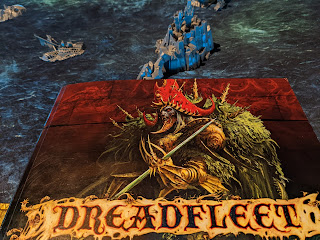 |
| DREADFLEET: best 'Big Box' game ever ??? |
DREADFLEET seemingly came out of nowhere back in 2011. It was Games Workshop's limited release "Big Box" standalone game that was easy to miss, and to this day has yet to be re-released...
I was thrilled and surprised to get a copy for the holidays that year. Now full disclosure, I'm not that into pirates... I never dressed up as one for a college party; I collected the medieval line of Legos, my older brother collected the Pirate ships, etc. The only time I remember liking anything with pirates was when I saw Swiss Family Robinson, and even then I think it was more about the sweet tree house they built that would put the Prince of Thieves' to shame.Anyway, I was watching The Sea Beast with my kids the other day and that movie really had them in the mood to play in that swashbuckling pirate setting... Enter DREADFLEET.
Overview
First things first. When you first open the glorious big box that is Dreadfleet, you are greeted with one of the highest quality game components that I've ever seen for any game: the 5 feet x 3.5 feet silky fabric ocean seascape that is the 'game board'.
Then the plastic minis don't disappoint either. The terrain pieces and all the ships are highly detailed plastic sculpts that can be push-fit without glue (which was kinda surprising how well this works and it's fun to be able to move the sails).
 |
| 180 guns! |
Scenario 1: Corpse Reef
The first mission eases the players into maneuvering the big flagships for each side, which is the first vital skill to master in order to even set up shots at opposing ships or boarding actions, let alone simply avoiding shipwreck obstacles on the seascape!
Turn 1: Movement and the winds of fate begin to sting...
OK, moving the ships is really fun and more challenging than you think. You get a cool fish spine movement gauge that pivots 45 degrees every 6", and another gauge (the gold one pictured above) to change direction of the ships (after any requisite wind & ship handling checks... I wont dive into every rule or detail here, but just know there is a depth to this aspect of the game that is really fun, however deep you choose to go 😉).
Then the cards, we have to talk about the cards for a second! They are not only pretty, they bloody track everything in the game that matters for you in a fun interactive way. This part of the game didn't get enough attention when it released, but highlights just how awesome good analog game design can be.
I have to say, when I first saw all the various cards this game uses in shrink wrap, it was overwhelming to say the least. But I'm happy to say I was totally wrong to assume that these would be daunting; they actually totally make sense, everything has a place and is pretty clear when & where you discard etc. The cards track everything so you don't have to remember and you are only ever dealing with a couple new fate cards a turn.
Find out what happens to the Heldenhammer flagship VS the dreaded Sea Giant in part 2...


























